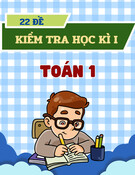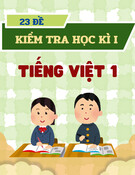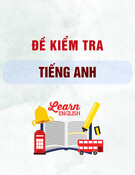
TRƯỜNG CD VĂN HÓA NGHỆ THUẬT VÀ DU LỊCH SÀI GÒN
ĐỀ THI ANH VĂN NGÀNH THÔNG DỊCH VIÊN ANH-PHÁP 2009 – 2010
THỜI GIAN: 90 PHÚT
Americans
have
benefited
in
some
way
from
(23)
people are still (24) of the power of big government. They are more
concerned about (25) own individual freedom than the common good of
the group.
Comprehension Check
I. Answer the
questions
1. What is the purpose of a primary election?
2. How are presidential candidates chosen?
3. What qualifications would be considered in choosing a presidential
candidate?
4. What is a “favorite son”? A balanced ticket?
5. What does a presidential candidate do to get elected?
6. What are the popular votes? What are the electoral votes?
7. What is Electoral College?
8. After the election who will be the president? In what situation does
no one win ?
II. Work in pairs. Number them 1-6 on the lines in correct order of the
steps in electing a president
Electors (members of the Electoral College) cast their votes for President
and
Vice President. The candidates with the majority of the electoral votes win.
Political parties hold national conventions to choose their candidates for
President
and Vice President. Convention delegates vote for the choices of the voters in their
states
The new President takes office during the inauguration (formal ceremony)
on
January 20 after the election.
If no candidate wins the majority of the electoral votes, the House

of
Representatives choose the new President.
All candidates campaign until Election Day, the first Tuesday after the
first
Monday in November. Then the voters make their choices.
Political parties choose their candidates in state caucuses (conventions) or
state primaries (elections).
III. What event are the terms about? 1 term may refer to different events.
Write
P if it’s about Primaries, N for National conventions, C for Campaigning, E for
Election
Day and I for Inauguration.
delegates
super-delegates
state
national
party
proportional
winner-takes-all
candidate
nomination
favorite- son
acceptance speech
a balanced-ticket
campaign rallies
a running mate
TV debates
news coverage
negativity
popular votes
electoral votes
Electora
5. (1619-1808) American slave traders captured black Africans and forced
them to work on plantations in the United States.
6. (1820-1860) During the Industrial Revolution, about 3.5 million Irish
Catholics left poverty and discrimination to work in America. They were
coal miners and railroad and canal builders. At the same time, many
Germans became farmers, laborers, and businessmen in the United States.
7. (1850-1870) After the Gold Rush in California, 200,000 poor Chinese
came to
work in mining camps and on the railroad.
8. (1850-1924) During the “Great Migration”, twenty-five million
Europeans of almost every nationality immigrated to America. They
included Russian and Polish, Jews, Slavic people from Eastern Europe,
Italians, Greeks, Armenians, and Syrians. Canadians, Mexicans, and
Central Americans came, too.
9. (1940s-1950s) The US welcomed thousands of refugees after World War II.
10.
(1960s-1990s) The U.S government abolished quotas for immigration from
non- European nations. Today, most immigrants are from Asian and Latin
American countries.


I/ True (T) or False (F)?
1. The Native Americans are all from the same tribes.
2. Christopher Columbus called the Native American “Indians” because he
thought that he was in the Indies.
3. The Native Americans felt happy to be given reservations
4. Footwear for skiers was invented by the Native Indians.
5. In 19th century, most immigrants from northern and western Europe were
farmers.
6. Many immigrants from southern and eastern Europe worked in factories.
7. Most European immigrants came to the US in the 1900s.
8. Hispanics are people who came from Spain.
9. There are two official languages in California, New Mexico, and
Colorado: English and Latin.
10.
After the Civil War, black Americans enjoyed freedom and equal rights.
11.
The civil rights movement fought for the release of Martin Luther King, Jr.
12.
Ellis Island has been the doorway to America for many immigrants since
1892.
13.
All the people coming to the United States were voluntary immigrants.
14.
Early Italian immigrants helped build the railroad systems in the USA.
15.
California has the largest foreign–born population.
II/ Write the dates from the box
1870s – 1930s 1820 – 1860 1600 -1776
1965 – 1990s 1921 - 1965 1619 -1808
1. Most of English immigrants came to the U.S between .
2. The U.S. received its first great immigrants from northern and western
Europeans between .
3. The black Americans were legally brought to America between .
4. Many people came to the U.S. from eastern and southern Europe
between
.
5.
The
U.S.
government
limited
on
the
immigration.
6. After the change in the Immigration Law, many people from Latin
America, the

Caribbean and Asia came to the U.S. between _ _
III/ Put the names from 1 to 7 in the order of time when they
immigrated to
America
WASPs
American
Indians
Chinese
Hispanics
Northern and Western Europeans
Eastern and Southern Europeans
African Americans
IV/ Which group(s) of American people do the following words relate to?
First immigrants
Old immigrants
New immigrants
non-immigrants
majority
Anglo-Saxon
non-white
Protestant
Catholic
Slavic
Nordic
Latin
bicultural
reservations
Civil Rights Movement
unwilling immigrants
political bosses
V/ Answer the questions
1. What did British immigrants give to the USA?
2. What are the three main reasons why immigrants have come to the USA?






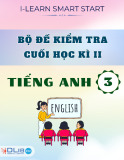


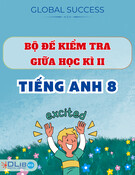
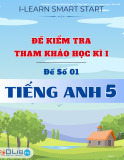

![Đề thi Tiếng Anh có đáp án [kèm lời giải chi tiết]](https://cdn.tailieu.vn/images/document/thumbnail/2025/20250810/duykpmg/135x160/64731754886819.jpg)
